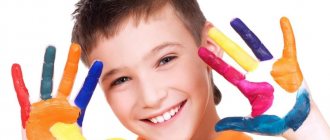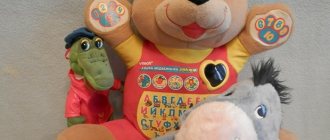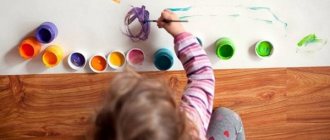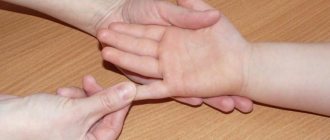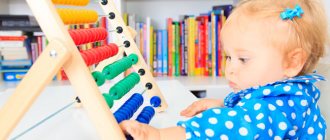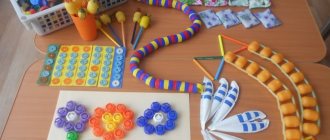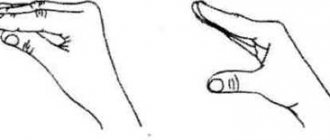Progress of the examination.
A large plush pillow and drumsticks are placed on the table in front of the child. The experimenter asks the subject to take the sticks in his hands and imagine that there is a drum in front of him, and he is the drummer. Show the child how to hit the “big drum”
(shoulder work)
. Then change the pillow to a smaller one:
“medium-sized drum” (elbow work)
.
The next “drum”
is small in size
(a small pillow is the work of the wrist)
.
Then invite the child to put down the sticks, imagine that there is a very small “drum”
- he needs to hit it with just his fingers.
All actions are performed first simultaneously with both hands, then alternately (symmetrical and asymmetrical hand work)
.
The differentiation of arm movements up and down was recorded: mobility of the shoulder, elbow, wrist, hand.
Task 2.3 “Policeman”
Purpose: to identify the development of movements of the shoulder girdle in various directions during symmetrical and asymmetrical movements.
Equipment: flags.
Progress of the examination.
The experimenter reminds the subject that in order to build a house, building materials are needed; reminds what parts the building consists of, demonstrates a finished example of a “house”
and offers
to “build”
your house, but to do this you need to cut out
“building material”
. The finished sample is not removed. The teacher can help you create a home.
The following was recorded: mastery of techniques for grasping objects (scissors, brushes, accuracy of execution.
Task 3.3 “Do embroidery”
(lacing game)
Purpose: to identify the development of coordination of the fingers when threading the lace into the hole, the development of coordinated (coordinated)
hand movements when
“embroidering”
.
Material and equipment: educational game for kids “Funny Laces”
(favorite fairy tales)
Progress of the examination.
The experimenter demonstrates to the subject how to hold the pencil correctly, how to press it so that it is bright; how to place your other hand so that the sheet does not wrinkle. Demonstrates execution. Then he invites the child to circle the balloons for Katya by dots. If the child copes with the task easily, he is asked to complete the drawing (symmetrically)
pattern on the ball.
The following was recorded: mastery of techniques for grasping an object, coordination of hands and fingers.
Task 3.2 “We are builders”
(application)
.
Goal: to identify the ability to wield scissors, a brush, and use the necessary grip on tools.
Materials and equipment: geometric shapes drawn on paper, scissors, glue, brush, napkin, oilcloth, brush cup.
Progress of the examination.
In front of the child, on the table, several medium-sized, round beads are poured out. The child is asked to take a fishing line and string beads onto it one by one. Depending on how the child copes with the task, he is then offered either large-sized beads, or beads of a more stable shape, or small-sized .
The following were recorded: mastery of the upper grip, coordination of the fingers.
Task 1.3 “Dress Katya”
Goal: to identify the consistency and accuracy of movements of the hand and fingers, the ability to perform asymmetric movements of the hands and fingers at a given pace.
Equipment: doll, clothes for the doll.
Progress of the examination.
The child is asked to fasten the buttons on the doll's jacket. Depending on how the child copes with this task, he is then asked to either put the jacket on the doll himself and fasten the buttons on it, or the doll in other clothes, on which the buttons must be fastened.
The following things were recorded: coordination of the hand and fingers, pace of task completion.
Series II. "Active handles"
Task 2.1 “Magician”
Purpose: to identify the state of mobility of the wrist and hand.
Progress of the examination.
The child is asked to imagine that he is a traffic controller on the road, give him flags; he must repeat all hand movements after the experimenter.
1. Movements are performed with both hands at the same time.
Arms up, to the sides, up through the sides, down, bend at the elbows, to the sides with the elbow up, down, forward, circular movements with the wrists, movements of the wrists up and down, circular movements with the elbows, circular movements with the whole arm, lower down.
2. Each hand performs its own movements.
Right hand - up, left - to the side; left - up through the side, right - down; left - down, bend your right arm at the elbow; pull the right one forward, bend the left one at the elbow; With your right hand, make circular movements with your wrist, with your left hand, make circular movements with your shoulder; lower the right one down, pull the left one forward; make circular movements in the shoulder with your right hand, with your left hand - with your wrist; hands down; stretch forward, make circular movements with your elbows in different directions, lower your arms down.
The following was recorded: differentiation of arm movements in different directions: mobility of the shoulder girdle.
Series III “Hands - needlewomen”
Task 3.1 “Ball for Katya”
(finishing drawing, tracing by dots)
Goal: to identify the ability to wield a pencil using the necessary grip.
Materials and equipment: paper with contours, a simple pencil (colored pencils)
.
Progress of the examination.
The child is asked to stretch his arms forward. Perform the following movements with each hand in turn: fist - edge - palm - rotating movements with the hand. Then perform the same movements with both hands at the same time.
The following were recorded: differentiated hand movements: wrist mobility, ability to perform actions in symmetrical and asymmetrical modes.
Task 2.2 “Drummer”
Goal: to identify the state of mobility of the shoulder girdle: shoulder, elbow, wrist, hand.
Equipment: plush pillows of different sizes, drumsticks.

